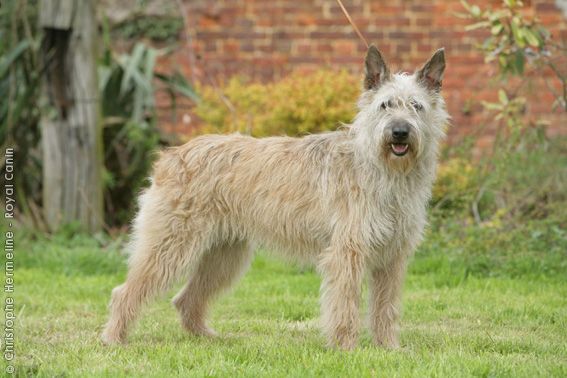
Back in the day, all Belgian dogs that worked with cattle were called bouviers (herders), and each area of the country had its own bouvier type.
For most people today, the name, “Bouvier” conjures up the mental image of the terrific breed we know as the Bouvier de Flandres, but there is another bouvier, and that’s the Bouvier des Ardennes. Of the original five Bouvier dogs, only the Bouvier des Flandres and the Bouvier des Ardennes remain. Sadly, the Bouvier des Roulers, Bouvier de Moermon, and Bouvier de Paret are now believed to be completely extinct.
Historically tasked to round-up, guard, and driving cattle in the Belgian Ardennes, the Bouvier des Ardennes has also been known as the Ardennes Cattle Dog, a breed with a reputation as being a “hard” breed, and hard working in harsh climate and difficult forested and mountainous terrain. They were also used to track deer and wild boar, and then during the two World Wars, they became poachers’ dogs. The disappearance of farms in the Ardennes in the 20th century coupled with the reduction in the milk cow herds impacted the number of all working dogs, including the Bouvier des Ardennes which, actually, was thought to have gone extinct.
In the best of surprises, researchers collecting colostrum from pregnant cattle in southern Belgium in 1985 noticed that many of the dogs hanging around the farms owned by local cattle farmers looked remarkably similar to the old Bouvier des Ardennes. In fact, they were Bouvier des Ardennes! By about 1990, a few breeders set out to produce dogs that adhered to the original standard of the breed which had been published in 1923. As an aside, in 1903, a dog named, “Tom” who’d been “discovered” by a Professor Reul at a Liege Dog Show may have been the example used to create the official breed standard as he was considered the ideal specimen of a drover’s dog.
Wait, it gets better.
In another big surprise, a few drovers and shepherds situated north of the country who had been astonished by the herding style and work ethic of the Bouvier des Ardenne began a breeding program from a line transplanted there around 1930. It was only in 1996 that the line was discovered by the official cynophile authorities!
What a marvelous story for a breed that was likely developed in the 17th or 18th Centuries. The breed that had been recognized by the Belgian Kennel Club in 1923 was now recognized (in 1963) by the FCI which published the Bouvier des Ardennes’ breed standard in 2002; the United Kennel Club recognized the breed in 2006.
You would not be the first to have the impression of similarity in appearance between the Bouvier des Ardennes and the Berger Picard, but we’ll save that discussion for another time.

The Bouvier des Ardennes is a very rare breed dog. I had met one family who breeds them at the WDS in Hungary a couple of years ago, and then we saw them again at the WDS in Leipzig. As with most rare breed dogs, the breeders and fanciers all know each other.
They have a natural bobbed tail, although not all of the dogs I have seen had bobbed tails. None of the Ardennes I have seen have tails as long as Picards. Per the standard, Picards’ tails must reach the hocks.
They are very much working dogs. Socialization is a definite must for this breed as puppies. They are much more comfortable in the field working stock.
Great feedback, Leanne! And we really appreciate the photograph. Your observation concurs with sources we found suggesting that this dog with a strong work ethic is happiest at work in a field!
Since professor Reul noted this breed, I first thought it was a spin-off from the Belgian Laekenois. But I see from the photo Leanne posted, that it is a different breed.
Yours is a good observation. Some scholars believe that the bouvier was crossed into Laekenois lines early in development.